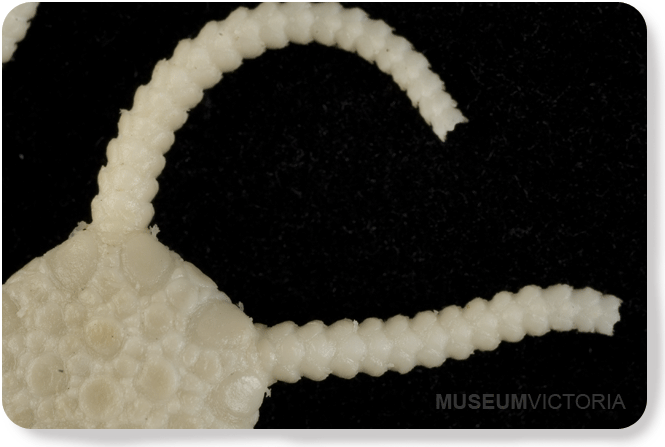
Home -> Species index -> Species description
 More images | Distribution map
More images | Distribution map | F 110596. Family - Ophiuridae. |
Description The disc is flat (arms inserted), 12 mm diameter. The radial shields are round, separated and parallel to one another, with 1–3 plates between them; 1–1.15 times long as wide, and length 0.17 times d.d. The dorsal surface is covered by plates, no spines/granules, with a visible diameter of 0.4–1.5 mm, touching, with distinct centrodorsdal plate; primary plates visible. The ventral interradial surface is plated. The oral shields are exposed, pentagonal, as long as wide. The adoral shields are exposed, proximal to lateral edge of oral shield or extending to lateral edge of oral shield, separated radially, meeting interradially. Bursal slits extend from the oral shield to the disc margin, bordered by spines or papillae, blunt or rounded, as wide as long, usually contiguous. The jaw is as wide as long, with one, pointed or tapering apical papilla, as wide as long. Oral papillae are present along each jaw angle in a series, quadrangular. The oral tentacle pore is located out of the jaw on top of the ventral disc, with a ring of scales surrounding the pore. The specimen has five arms, unbranched, basally constricted, 2–3 times d.d. Dorsal arm plates, separated, without spines/granules; diamond or fan-shaped, and carinate, and 1.3–1.65 times long as wide. The second ventral arm plates are separated from the third plate, fan-shaped, notched or concave laterally, and 0.6–0.75 times long as wide. Ventral arm plates of the first free segments separated, diamond, notched or concave laterally, and 0.45–0.6 times long as wide. Tentacle pores along the arm, with several scales as a ring of many scales around the pore, reducing in number, covering the pore, pointed or oval. There are 0 arm spines on the first ventral segment, 1–2 on the first free segments. The spines are adpressed to arm, extending laterally, subequal, and 0.1–0.25 times as long as one arm segment, pointed, cylindrical.
Description exported from Delta key and to be finalised when DNA sampling completed. Note species description and image characters may vary slightly in animals of different size within the same species. Cite this publication as: "T O'Hara
(2010). ‘Ophiuroids from deep sea southern Australia. Museum Victoria. Version:
1.0 http://www.museumvictoria.com.au/stars" MUSEUMVICTORIA |